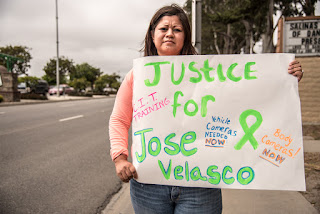On June 1 the Lecturer's labor contract at UC Santa Cruz expired, and union members with American Federation of Teachers Local 2199 and their supporters marked the day by picketing - and picnicking - at the base of campus. Messages in support of adjunct-faculty members and a more democratized University of California system were displayed as individuals held several large, colorful puppets. Food was served, and the day-long event was dubbed "St. Precaria's Picnic."
Lecturers are non-tenure track adjunct-faculty members. They say that they are not treated like professionals, even though they teach classes, engage in writing and research, and hold advanced degrees from top universities. Across the University of California system about one-third of all classes are taught by Lecturers, and contingent faculty members teach over half of the UC's undergraduate credit hours in total, if graduate student teachers are included in the equation.
The majority of Lecturers are hired year-by-year or quarter-by-quarter as "temp" workers, which leaves them with no job security. Additionally, a full-time Lecturer's workload is typically twice that of a tenure track professor, yet they are paid significantly less.
Many of the picket signs displayed at the picnic communicated around the theme of precarity. One such message, "A Precarious Faculty = A Precarious University," was emblazoned on a gold flag along with the stencil of a fist holding a pencil.
Precarity has been defined as a condition of instability in the workforce created in postindustrial societies when management seeks to increase its own strength by limiting job opportunities to temporary and or part-time work.
In February, organizers of the National Adjunct Day of Action adopted "Saint Precaria" as their "icon saint" and individuals at UC Santa Cruz continue to develop themes surrounding precarity.
"All these movements that we are building together are really interconnected, all the student movements and the union movements that we have been working on for many years together," explained Josh Brahinsky at a mid-day rally held at the picnic. Brahinsky teaches courses at both UC Santa Cruz and San Jose State University.
"We're all facing a certain kind of neo-liberal budget where they play with it, and mess with the money," he said. "They don't spend the money on undergraduate education, which is what we are all here to make happen."
Brahinsky said that the University of California has, "made a priority out of administrative spending," noting that it has increased by over 250% in the last 20 years. The growth of faculty spending over the same time period has only increased by 50%, he said, adding that 20 years ago there were five faculty members for every two administrators, but the figure has shifted dramatically, and presently there are only five faculty members for every six administrators, on average.
"The administration is growing and has surpassed the faculty," he said.
"The priorities of the UC are something that ought to be democratic," Brahinsky said. "We can have a say in that, and so we should."
To learn more about the University of California's budget, Brahinsky recommended attendance at a workshop to be held by Autonomous Students UCSC, a student organization that was tabling at the picnic.
AFT Local 2199 President Roxi Power also spoke at the mid-day rally, as did Mike Rotkin, AFT's longest running President at UC Santa Cruz.
After the speakers were heard, a street theater segment was performed with UC administrators portrayed as top-hat wearing characters from the Monopoly board game. Many participants were dressed in graduation gowns, and union members distributed the lyrics to a variety of songs to those in attendance so that the group could serve as the musical chorus in the skit.
One song was titled "Carry that Debt" and was performed to the tune of "Carry that Weight" by the Beatles. The lyrics were modified with new verses such as "You never give me your money, You only give me your crowded classrooms, And in the middle of negotiations, You break down," and a chorus of, "Oh, you're gonna carry that debt, Carry that debt a long time."
 |
| Roxi Power, UCSC Lecturer and President of AFT Local 2199, speaks. |
 |
| Mike Rotkin speaks. |




































































